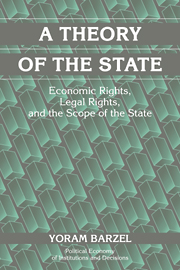Book contents
- Frontmatter
- Contents
- Preface
- 1 Introduction
- I The Emergence of Protection and Third-Party Enforcement
- II The Emergence of Legal Institutions
- III The Character of the State
- 12 Merger and Local Autonomy
- 13 The Distinction between “Legitimate” and “Criminal” States
- 14 Power, Violent Conflict, and Political Evolution
- 15 The Time Path of Change under Dictatorships and under Rule-of-Law Regimes
- 16 Recapitulation and an Epilogue
- References
- Index
- Other Books in the Series
16 - Recapitulation and an Epilogue
Published online by Cambridge University Press: 04 December 2009
- Frontmatter
- Contents
- Preface
- 1 Introduction
- I The Emergence of Protection and Third-Party Enforcement
- II The Emergence of Legal Institutions
- III The Character of the State
- 12 Merger and Local Autonomy
- 13 The Distinction between “Legitimate” and “Criminal” States
- 14 Power, Violent Conflict, and Political Evolution
- 15 The Time Path of Change under Dictatorships and under Rule-of-Law Regimes
- 16 Recapitulation and an Epilogue
- References
- Index
- Other Books in the Series
Summary
RECAPITULATION
In this book I am attempting to model the emergence of the state and follow its development, primarily when it evolves toward the rule of law. In the model I develop, all individuals, including the Hobbesian king, are assumed to be maximizers. As they begin to socialize, they first do not allow members of the society to specialize in the use of violence, in order to avoid dictatorial takeover by such specialists. However, when threatened by outsiders, they will allow such a specialist to emerge to help protect the members of the society, but only after they form a collectiveaction mechanism that will be able to control the specialist. The emergence of a specialized protector who adjudicates disputes and enforces his decisions defines the state.
The enforcement of agreements is a major feature of the model. The reason is that in only a subset of all agreements has the state a comparative advantage in enforcement; other agreements will be self-enforced or enforced by other third parties. The determination of which agreements the state will enforce and what fraction of all agreements it will enforce will determine the scope of the state.
Underlying this book is the methodology of the economics of (not well defined) property rights or of (positive) transaction costs, which by my definition is its dual. It models a world that radically departs from that underlying the Coase theorem, where economic property rights are (somehow) everywhere well defined. Institutions, including the state, are superfluous in such a world. Such an idealized world cannot exist, however. Indeed, there is no niche in reality where property rights can be fully and costlessly delineated.
- Type
- Chapter
- Information
- A Theory of the StateEconomic Rights, Legal Rights, and the Scope of the State, pp. 267 - 276Publisher: Cambridge University PressPrint publication year: 2001

